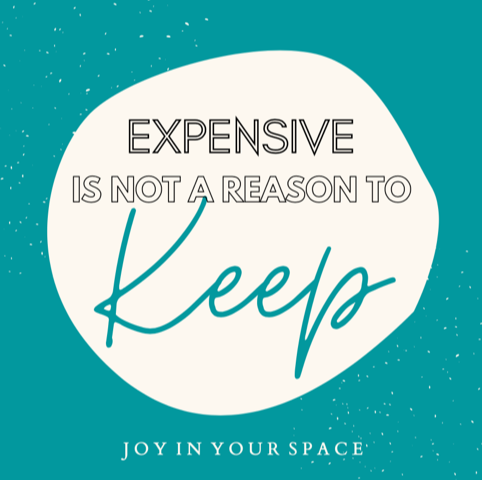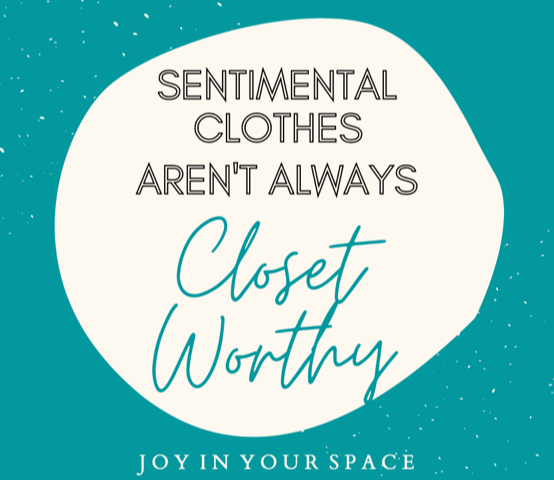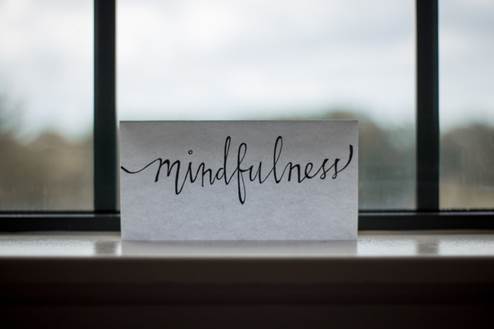By Kelly Galfand, JOY IN YOUR SPACE, 610-896-6896
My role as organizer usually involves helping people:
• live with less
• have more within easy reach
• love what they store.
One popular area I organize is wardrobe closets. Sometimes I’m hired to fix a physical problem; I solve storage challenges. Sometimes I am the necessary support as someone decides:
• what to keep
• where to donate or sell
• how to let clothes go.

In my experience, even when someone commits to trimming their wardrobe, there is one item they want to get rid of but (in their words) “can’t!” In these situations, what’s really behind their “can’t” is guilt.
When I hear a closet client say “I can’t get rid of this,” I know the clothing in question was either expensive, a gift, or it holds sentimental value.
• If the item was expensive… and they haven’t worn it (ever or enough), the struggle is about throwing good money away. But honestly, they’re wasting more money by storing this item. Waiting too long to resell something is not smart; the resale market pays more for recent purchases.
• Check out resale avenues like TheRealReal, PoshMark, Clothes Mentor, Plato’s Closet, and ThredUp depending on the item’s value.

• If the item was a gift… from someone they love, their love for the person is getting in the way of their ability to decide what they want in their life. They sometimes think that letting the item go is akin to rejecting the gift-giver’s love, kindness, or generosity. Trust me, your favorite aunt knows you love her even if you don’t love the winter hat she gave you. I always reassure clients that no one gives a gift in order to burden the recipient. A recipient’s only responsibility is to be gracious in accepting the gift.
• —You can always donate the item or its value to a charitable organization the gift-giver supports to lessen the pain of letting the item go from your life. Let it be a gift that keeps on giving — to someone else!

• If the item holds memories it will fall into one of two categories:
• Clothing from the person’s own life (even if it was someone else’s at some point)
When I come across these sentimental clothes, the first question I ask is: Will you still wear it? If the answer is “yes,” it can stay.
If the answer is “no,” then I suggest the t-shirt, wedding gown, or cheerleading skirt move to a spot more suitable to memories and nostalgia.
• Clothing that holds memories may have belonged to a deceased loved one. I help people navigate these sensitive areas often. What I counsel, is to keep only the sweatshirts, t-shirts, or hats that meant something to the departed and mean something still to you if you have room for it.
If it’s something you aren’t going to wear, display it to honor it in some way. Shadow boxes are wonderful conversation pieces and visual reminders of our ancestors’ legacies.
To me, your adored Uncle’s memory does not hinge on a single t-shirt…not even on his entire t-shirt collection. I recommend that if you let items go from your life (that belonged to someone you loved) decide how you will remember this person (in thought or deed) once you let the item go. Then be intentional in keeping their memory alive.

Infants grow fast — I’ve had piles of clothes to prove this fact. Nearly as fast as they’ve grown into their newest cute new outfits, they’ve outgrown them already! Having a plan for keeping up with this constant rotation will save you time in the future and reduce the stress of potential growing piles. Whether or not you hope to use the clothes for future children, here are a few quick-to-tackle tips for getting ahead of the clothing clutter.
Not saving anything? Get ahead of the clutter.
Determine the spot you’ll use for temporarily stashing outgrown items. I use a basket under my son’s crib, but you can use a paper bag, box, or large trash bag on a shelf or in a closet. The laundry room is a great place, too. From now on, every time you determine something no longer fits your child, put it in your temporary storage bin. Add to this bin until it’s full, then mark it with the approximate size(s), stick the box/bag in your car, and drop it off for donation. Likely you have friends with kids and could also drop off the box on a porch for hand-me-downs. More on donations at the end.
If you know you’ll be keeping some clothes for future children, read on.
Get Clothes Prepped for Future Kids
First, determine a spot you’ll use for temporarily stashing outgrown items. I use two baskets under my son’s crib, one for items I’m keeping and one for giving away, but you can use paper bags or boxes in the laundry room, on a shelf or in a closet, or large trash bags (clearly marked and stored out of reach of the littles), etc.
Next, Every.Single.Day and Every.Time you determine something no longer fits your child, decide if you liked this outfit/item and put it in the keep bin, if not, put it in your give-away bin. Add to these bins until full. Then transfer the give-away items to a box marked with the approximate size(s) and check out donation options below. For the clothes you’re keeping, transfer to a storage bin, vacuum sealed bag or other favorite storage solution. I tend to have extra diapers that are outgrown, so I fill diaper boxes with unused/outgrown diapers and clothing from roughly the same size. Taking 1 minute each day will save you the hassle of sorting through a huge pile later.
Options for Clothes You’re Not Keeping
Depending on your interest and time commitment, you have a few options in addition to those mentioned above. From approximately most to least time consumed:
Final Thoughts on Outgrown Clothing
It’s best to donate items you’d use again and toss anything too worn out. If your kids are older and aware of “favorite” pieces, go through this process with them, so they learn from you how to stay organized and be generous with their clothes! For the babies, an everyday, constant rotation keeps clothes that fit available and stops piles from accumulating to keep the nursery looking lovely.

Day 365 + ???? (who’s counting) of the pandemic and it seems like everyone is decluttering. We’re all trying to hold true to our reoccurring New Year’s Resolution to ”Get Organized.” Getting Organized can mean different things to us but it usually involves some sorting and culling of categories of stuff.
In our experience, there are always 3 decision buckets your stuff will fall into:
Our NAPO colleague, Barbara Hemphill, coined this brilliant definition: Clutter is Postponed Decisions.™ Clutter builds when we postpone decisions about:
• Do I really love it?
• Will I use it?
• Does it fill a void in my life?
• If I’m keeping it, where should it live?
While you do need to decide about your stuff, you do NOT want to stop the decluttering process to ponder each individual item.
Our time-saving advice is DEFER your decision for the “maybes” and “I don’t knows.”
These tricky decisions deserve attention — but NOT while you’re in the initial stages of rapid-fire, gut reactions to your stuff.
If you stop your intuitive process of deciding Yes, No, Maybe you won’t get through the whole category of stuff and you won’t see visible signs of progress. This will feel depressing and probably halt the whole decluttering process.
Follow our advice and schedule time with yourself — on a separate day — when your mind is fresh and you’ll taste sweet success. Technically, it’s called time chunking. In practice:
• One organizing session is dedicated to quick, visceral decisions.
• Another for contemplative, thoughtful and reasoned thinking.
Permission granted to defer your decisions on all of your “maybes” and “I don’t knows” — not because pushing off until tomorrow is a winning strategy. Permission granted because setting aside the necessary time to consider what deserves a place and space in your life is worthy of your full attention. In this case, deferring the decision is a smart move.
By Geri Chark Frankel, GCF Organizing LLC, (856) 296 6605

Kudos to you! Somehow you have found a few minutes to read this blog during this busy holiday season. How did you manage it?
Is it a much-needed break from work? Are you avoiding a task you just can’t face right this minute? Are you a passionate follower of all things about organizing? Do you want to honor your NAPO colleague by reading her words?
I am curious about your answers, and welcome you to explore them. First, there is no right answer. There is YOUR answer. And to get to that answer, I’d like to you give yourself permission to:
STOP – PAUSE – REFLECT. Did any insights rise up? Did you get a glimmer of what your priorities are? Should be?

Now let’s take this tool and use it as you head into a New Year… and into any organizing/time management/productivity project large or small about which you feel stuck.
For example, you have a huge amount of memorabilia: inherited from relatives, reminders of your childrens’ youth, and your own school, personal and work papers. This stuff all reminds you with what your life has been woven together. Maybe it even symbolizes your core identity. It’s hard to let to go. Even editing them down, creating digital (photos, scans) records of them does not seem possible.
So let’s STOP PAUSE REFLECT. And ask yourself this: What Matters Most To Me NOW? Is it making room for other activities in the space now clogged with memories of the past? Is it giving myself a beautiful space in which to create my life today? What are my core needs and values, and how might they be best served?
In my experience working with hundreds of clients over the years, they all know these answers, deeply and profoundly. Decluttering and creating a life that reflects who they want to be is greatly facilitated by taking the time and energy to develop the self-awareness that bursts forth from mindfulness. Give it a try!
Wishing you joy during this holiday season,
Geri Chark Frankel
GCF Organizing LLC
Ah, new relationships! They can be fun and exciting, right? You love being together every day, you fall deep into the honeymoon period, and you feel that your partner is the best thing ever…
Hmm…do you remember mid-March, and a certain technology that blew up? Read the sentence above replacing Zoom with your partner…still works, right!
Yes, Zoom! I remember that gut wrenching feeling of being alone when we first learned that much of the world had shut down. Add living alone to that and it can really throw you for a loop.
My networking group started moving onto the platform that many of us were just starting to learn about. Working through kinks, like Zoom bombers, the leaders of our group helped us navigate through our new normal and suddenly I was with my friends again! It felt SO good!
I was on every day for a while, either networking, with friends, or with family, going to Zoom birthday parties and gathering for Zoom trivia nights. On my birthday in May, my friends threw me a surprise Zoom birthday and more friends appeared flash mob style to one of my favorite songs.
I loved Zoom! I couldn’t get enough of Zoom, until the day came that I could. Just like the honeymoon phase in a relationship, my relationship with Zoom peaked, and I reached the level of Zoom Fatigue, which many of us are facing today.
I just didn’t want to be on it anymore and faced that alone feeling again. I learned to fill my days in different ways, and after a while, as the world was starting to open up a bit, I started new routines with more balance.
Zoom is still a part of my new normal. I became a part of an accountability group with a few friends, go to a few networking meetings a week and even started virtual organizing with clients.
If you are still in the fog of Zoom Fatigue, here are some things to try to make being on it fun again:
So, learn to love Zoom again, but try to keep a life balance, and leave the honeymoon period for people, not the latest tech craze. Wishing you, your family, and your friends, a happy and healthy Fall!

In 2015 Forbes reported a Bureau of Labor statistic affirming that, in 1930, the average American woman owned 9 outfits. This, as opposed to a current day figure of about 30 outfits – one for each day of the month.
In 2016 a survey of 1,000 American women was conducted by ClosetMaid. It found that women only really like 10 percent of their wardrobe. It also found that one in ten women are depressed when they open their closet and 40 percent say that they don’t like any of their clothes.
As Americans, we are blessed with an abundance of choices when it comes to clothing and fashion. A broad variety of style, quality and affordability surround us. Yet, we can surmise from these two studies that, in the U.S., we have more clothing than ever before and are less satisfied with what we have. So where does the disconnect lie? How do we get from Point A – the clothing that we own; to Point B – happiness?

There are many explanations centered around the social and psychological motivations behind our large wardrobes and our dissatisfaction. Compulsive shopping, ecological reasoning, “retail therapy”, depression and loss are just a few theories offered.
The anxiety experienced when contemplating and processing the variety and abundance we face upon viewing our overcrowded wardrobes adds a real neurological strain. We end up starting our days stressed-out even before we walk out our front door.
Although it remains important to address the underlying reasons for overwhelmed and overwhelming closets and spaces, professional organizers (unlike therapists) also get the opportunity to directly address the physical issues as well. Addressing spacial congestion is empowering, encouraging a feeling of control over the environment, a feeling that can help ward off anxiety and depression.
Here are three simple tips for actions that you can take today that will make a difference every day.
Start with unused hangers and empty boxes that take up space for absolutely no reason. A dozen empty hangers can take up to a foot of space on your hanging rod – a whole foot! There may be many hiding between crowded garments so be sure to filter through everything. Next, begin at one end and review each garment. Remove all items that can be tossed or donated; toss the trash, then bag and label the rest for “Donation”.
Unless you live in a temperate climate where your entire wardrobe is versatile for year-round use, there are very few reasons to keep all of your clothing at hand in your closet all of the time. Separate items you are keeping into two seasonal categories: Fall/Winter and Spring/Summer. Keep the current half at hand in your closets and dressers. Store the other half in plastic bins or space bags. Take advantage of the seasonal switch to purge items that you no longer want before storing the rest.
Okay, I will admit that this may sound a little “organizer”-geeky, but try it out before you scoff. Imagine you are looking for your favorite pair of black pants. The ones that fit just right and aren’t too long or too short. Do you have to go in between all your tight spaces in your closet to find them before realizing they are at the cleaners? Not if your closet is color coordinated. You will simply go through the section of black pants. Not there? Then they are in the laundry. Need to put together a quick outfit? Easy to do when your eyes are simply matching colors and not hunting between randomly hung, tightly crammed fabrics.